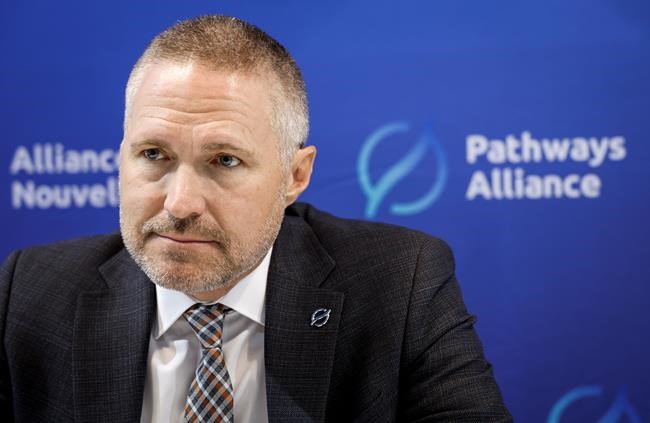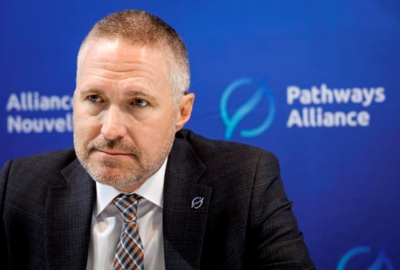
CALGARY — The group behind a proposed carbon capture and storage (CCS) network for Alberta’s oilsands is watching the Trans Mountain pipeline expansion’s latest regulatory hurdles with dismay.
The Pathways Alliance, a consortium of Canada’s biggest oilsands companies, wants to get its proposed $16.5-billion carbon pipeline and underground storage hub up and running in northern Alberta by 2030.
The project as proposed would be one of the largest carbon capture projects in the world, linking up to 20 CCS facilities in northern Alberta and sequestering 10 to 12 million tonnes of carbon emissions from oilsands sites annually.
It is key to the oilsands industry’s commitment to achieve net-zero greenhouse gas emissions from production by 2050 — something it must do in order meet Canada’s international climate commitments. The oilsands industry currently accounts for about 12 per cent of Canada’s overall emissions.
But the Pathways project is facing its own set of political and regulatory uncertainties, which it must clear before construction can begin. And the group’s president Kendall Dilling says the Trans Mountain pipeline is a case study in how hard it can be to get major infrastructure projects across the finish line in this country.
“I’m not going to lie, that keeps me up at night,” Dilling said in an interview at the World Petroleum Congress taking place this week in Calgary.
“We look at that (Trans Mountain), and that’s not a good outcome for anyone.”
The Trans Mountain pipeline is Canada’s only pipeline system transporting oil from Alberta to the West Coast. Its expansion, which is currently underway, will boost the pipeline’s capacity to 890,000 barrels per day (bpd) from 300,000 bpd currently.
The project, which is owned by the federal government, was expected to be in service early next year but now may not be ready until December 2024.
The Crown corporation in charge of the project has run into fresh construction issues in British Columbia, and a B.C. First Nation is opposing the company’s efforts to modify the pipeline’s route as a result.
The Canada Energy Regulator heard arguments from both Trans Mountain Corp. and the First Nation earlier this week, and is expected to issue its decision on the matter shortly.
It’s the latest hurdle for a project which has already run into everything from environmentalist opposition to ballooning labour costs and supply chain challenges to construction woes caused by extreme weather.
The estimated capital cost for Trans Mountain, which was bought by the federal government for $4.5 billion in 2018, has already spiralled to $30.9 billion, and the company has said its most recent challenges could add an additional $86 million to the final price tag.
Pathways, which hopes to apply for regulatory approval for its project this fall with the goal of putting in its first purchase orders for pipe in early 2024, simply must not encounter setbacks like that, Dilling said.
“We’re doing everything we humanly can to keep this on track for 2030. But we are getting to a really critical juncture. We’re on a critical path, there’s no room to give,” he said.
Pathways is still waiting for the federal government to finish hammering out the details of its pledged investment tax credit for carbon capture and storage, as well as a promised framework providing certainty about the future price of carbon — which would remove some of the investment risk from the project.
In addition, Pathways recently started formal consultations with 24 Indigenous and Métis groups whose traditional territories are located in close proximity to the proposed project.
One of these groups, the Cold Lake First Nation, told CBC News earlier this month that it has concerns about the project, and it feels Pathways is “ramming it down our throat.”
Pathways is working to address First Nations’ concerns, Dilling said, adding the group has always believed “there is no project” without positive partnerships with Indigenous neighbours.
“You look around the country, you look at recent projects — getting that stakeholder alignment is so critical or these projects can just churn and churn and churn for a long time,” he said.
Part of the reason the 2030 time frame matters to the Pathways group is the federal government has set an interim target of reducing Canada’s emissions by at least 40 to 45 per cent below 2005 levels by 2030.
The government is expected to unveil a mandatory emissions cap for the oil and gas sector, aimed at helping to achieve that goal, later this fall.
But as the clock ticks down, Dilling said he believes it’s more important to complete the Pathways project in a “thoughtful, managed” way than to try to jam it in before an “arbitrary” deadline.
“It’s not just us, it’s all these sectors that are moving toward 2030. If you end up just doubling the cost on all of these projects because you’re trying to push too much through that funnel, that doesn’t serve anyone’s purpose,” he said.
Still, he said, Pathways is committed to going as fast as it can.
“You can’t say that you’re on a journey to 2050, but you’re going to do it all in the 2040s. No one will give you that runway,” he said.
“We’ve got to show major progress — steel in the ground.”
This report by The Canadian Press was first published Sept. 21, 2023.
Amanda Stephenson, The Canadian Press
Share This:






